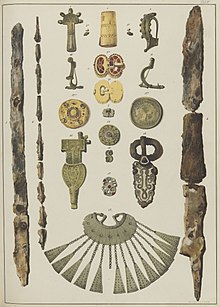Prince's grave from Ailenberg

The Prince's grave from Ailenberg is an Alemannic male grave from the second half of the 5th century. Due to the valuable grave goods, the buried person is assigned to the Alamannic ruling class.
Location
The Ailenberg, formerly called Ölberg or Öhlenberg, is located between Obertürkheim and Rüdern . It is a mountain tongue that protrudes prominently into the Neckar valley . At the highest point of the mountain, the wine grower Karl Kopp from Rüdern found a grave in 1857 when he was removing earth from a quarry edge. According to the statement at the time, the site was about 50 steps northeast of the Mélacturm . The Württemberg Alterthumsverein was informed about the Esslinger Schultheiss Marchthaler , which in turn commissioned Karl Eduard Paulus with the research. He created an exemplary report for the time in the annual journals of his association. The distance given has recently been disputed, as the quarry is about 125 m away according to the old land maps.
Find
The grave pit was 0.9 m wide and 1.2 m deep in the Keuper marl. Above it was a 1.3 m thick layer of rubble with prehistoric fragments of bricks, bricks and vessels. The whole thing covered a 1.8 m thick layer of humus, which was later piled up for wine growing. Paul had to rely on the story of the finder and a court notary for his notes because the grave had been cleared. Only the cavity in which the skull was located was visible. Paul wrote: "According to his own experience, the deceased [...] was facing the east." According to the then Esslingen senior medical officer Kapf, it was a well-built man who was around 30 years old. On the side of the man on which is no longer known, were spatha and leg plates of a reflex arc and on the opposite side, a narrow Langsax with a bundle of three-lobe arrowheads. In the hip area were a gold belt buckle and a gold sheet metal socket. The original position of two gold rivets, a bronze buckle, an iron fitting in the form of a tulip and several silver and iron fragments could no longer be determined. Some finds were lost until the 1930s; only the gold objects survived the Second World War .
Mainly because of the splendid belt buckle with garnet inlays, the buried person is seen as part of the Alemannic ruling class. The place of origin of the incorporated almandines was assessed as " Indian in the broadest sense" . Similar finds are only found in the so-called "princely graves " of Apahida in Romania and the grave of Childerich I in Tournai . The sheet gold socket with geometric decorations is assigned to the handle of the narrow long saxe. If you saw such jewelry and armament in connection with the influence of Hunnic equestrian nomads, it is now recognized that Byzantine influences are present here.
As early as 1846, a grave with no grave goods was found nearby. It cannot be said whether there is a connection.
See also
literature
- Karl Eduard Paulus : Finds from German graves . In: Jahreshefte des Wirtenbergischer Alterthums-Verein Volume 1, Issue 11. Stuttgart 1844–1869 ( digitized version ).
- Rainer Christlein : Weapons from the grave find of Esslingen-Rüdern during the Migration Period . In: Germania 50, 1972, pp. 259-263.
- Dieter Quast : Rüdern . In: Johannes Hoops, Heinrich Beck, Dieter Geuenich (Hrsg.): Reallexikon der Germanischen Altertumskunde . 2nd Edition. Vol. 25, Verlag Walter de Gruyter, Berlin - New York 2003, ISBN 978-3-11-017733-6 , pp. 416-417.
- Christoph Engels: Excavations on paper: archives and files on the early Merovingian grave of Rüdern (City of Esslingen am Neckar), 150 years after its discovery. In: Archäologisches Korrespondenzblatt vol. 37, 2007, pp. 569-583
Web links
Individual evidence
- ↑ Dieter Quast: Rüdern . In: Johannes Hoops, Heinrich Beck, Dieter Geuenich (Hrsg.): Reallexikon der Germanischen Altertumskunde 2nd edition, vol. 25. Verlag Walter de Gruyter, Berlin - New York 2003, p. 416.
- ^ Rainer Christlein: Weapons from the grave find of Esslingen-Rüdern during the Migration Period . In: Germania 50, 1972, p. 259.
- ↑ Christoph Engels: Excavations on paper: archives and files on the early Merovingian grave of Rüdern (City of Esslingen am Neckar), 150 years after its discovery. In: Archäologisches Korrespondenzblatt vol. 37, 2007, p. 570
- ^ Rainer Christlein: Weapons from the grave find of Esslingen-Rüdern during the Migration Period . In: Germania 50, 1972, p. 260.
- ↑ Christoph Engels: Excavations on paper: archives and files on the early Merovingian grave of Rüdern (City of Esslingen am Neckar), 150 years after its discovery. In: Archäologisches Korrespondenzblatt vol. 37, 2007, pp. 573,576
- ↑ Dieter Quast: Rüdern . In: Johannes Hoops, Heinrich Beck, Dieter Geuenich (Hrsg.): Reallexikon der Germanischen Altertumskunde 2nd edition, vol. 25. Verlag Walter de Gruyter, Berlin - New York 2003, p. 417.
Coordinates: 48 ° 45 ′ 47.5 " N , 9 ° 16 ′ 34.3" E
